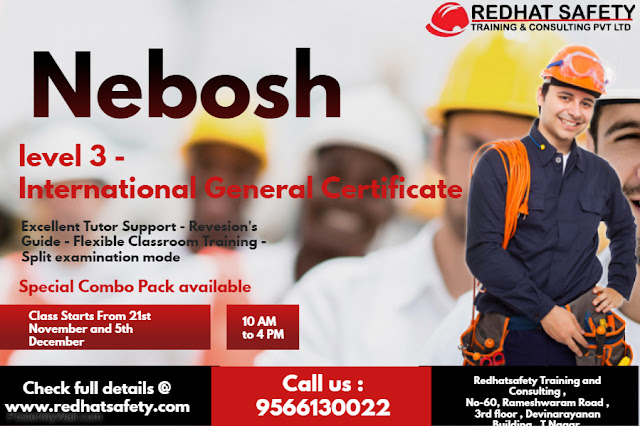All business do need some sort of Safety Courses. In industries, the Managers and Executives need to have gone through these courses. NEBOSH courses are the leading safety courses available in the world today.
NEBOSH, the acronym stands for National Examination Board in occupational Safety and Health. NEBOSH doesn't supply health and safety courses, rather it provides syllabuses to authorised course suppliers like Redhat Safety, who provide health and safety courses to prepare candidates for NEBOSH qualifications.
41. Who Investigates? ● ● Major Accidents - NOAA “GO TEAM”
Investigation Team - LO Representative - Other agencies such as NTSB, USCG,
OSHA Minor Accidents - First-Line Supervisor - Site Director or Manager - Site
Safety Representative - NOAA SECO (if needed)
48. What’s Involved? Who was injured? ● Medication, drugs, or alcohol? ● Was
employee ill or fatigued? ● Environmental conditions? ●
41. Who Investigates? ● ● Major Accidents - NOAA “GO TEAM”
Investigation Team - LO Representative - Other agencies such as NTSB, USCG,
OSHA Minor Accidents - First-Line Supervisor - Site Director or Manager - Site
Safety Representative - NOAA SECO (if needed)
42. Investigator’s Qualifications ● ● ● ● ● ● ● Technical
knowledge Objectivity Analytical approach Familiarity with the job, process or
operation Tact in communicating Intellectual honesty Inquisitiveness and
curiosity
43. When to Investigate? ● Immediately after incident ● Witness
memories fade Equipment and clues are moved Finish investigation quickly
44. What to Investigate? ● All accidents and near-misses -
Conduct investigation upon first notification - Keeping the scene in-tact and
recording witnesses statements early is key to a successful investigation
45. Accident Investigation Kit May Include: ● Digital Camera ●
Report forms, clipboard, pens ● Barricade tape ● Flashlight ● Tape measure ●
Tape recorder ● Personal Protective Equipment (as appropriate)
46. The Accident Occurs ● ● ● ● ● Employee or co-worker
immediately reports the accident to a supervisor Supervisor secures/assesses
the scene to prevent additional injuries to other employees, before assisting
the injured employee Supervisor treats the injury or seeks medical treatment
for the injured The accident scene is left intact Site safety rep is contacted
to assist the supervisor in the investigation of the accident.
47. Beginning the Investigation ● ● ● ● ● Gather investigation
members and kit Report to the scene Look at the big picture Record initial
observations Take pictures
48. What’s Involved? Who was injured? ● Medication, drugs, or alcohol? ● Was employee ill or fatigued? ● Environmental conditions? ●
48. What’s Involved? Who was injured? ● Medication, drugs, or alcohol? ● Was employee ill or fatigued? ● Environmental conditions? ●
49. Witnesses Who witnessed the accident? ● Was a supervisor or
Team Lead nearby? ● Where were other employees? ● Why didn’t anyone witness the
accident (working alone, remote areas)? ●
50. Interviewing Tips ● ● ● ● ● Discuss what happened leading up
to and after the accident Encourage witnesses to describe the accident in their
own words Don’t be defensive or judgmental Use open-ended questions Do not
interrupt the witness
51. What was Involved? ● ● ● ● Machine, tool, or equipment
Chemicals Environmental conditions Field season prep operations
52. Time of Accident Date and time? ● Normal shift or working
hours? ● Employee coming off a vacation? ●
53. Accident Location ● ● ● ● ● Work area On, under, in, near
Off-site address Doing normal job duties Performing nonroutine or routine tasks
(i.e., properly trained)
54. Employee’s Activity ● ● ● Motion conducted at time of
accident Repetitive motion? Type of material being handled
55. Accident Narrative Describe the details so the reader can
clearly picture the accident ● Specific body parts affected ● Specific motions
of injured employee just before, during, and after accident ●
56. Causal Factors ● ● ● ● Try not to accept single cause theory
Identify underlying causes (root) Primary cause Secondary causes Contributing
causes Effects
57. Corrective Actions Taken ● ● Include immediate interim
controls implemented at the time of accident Recommended corrective actions
Employee training Preventive maintenance activities Better operating procedures
Hazard recognition (ORM) Management awareness of risks involved
58. Immediate Notification ● Supervisor shall complete the NOAA
Web Based Accident/ Illness Report Form and submit within 24 hours of incident
occurrence (8 hours for major incidents).
59. Accident Analysis Summary ● ● ● ● ● ● Investigate accident
immediately Determine who was involved and who witnessed it Ascertain what
items or equipment were involved Record detailed description Determine causal
factors Implement corrective actions
60. 1. What is an Accident Investigation? a. b. c. d. A
systematic approach to the identification of causal factors and implementation
of corrective actions. Finding personal fault and placing blame. The
appropriate steps to prevent future actions. The essential step to determine
trends and taking action against person or persons at fault.
61. 2. Which Accidents should be Recorded or Reported? a. b. c.
d. Only on the job accidents. ALL accidents (including illnesses) shall be
recorded and reported. Only on the job accidents on illnesses that occur on the
job and reported within 8 hours. All accidents shall be recorded and reported.
62. 3. Why Investigate Accidents? a. b. c. d. To develop and
implement corrective actions. To document the events. The Primary Focus is to
PREVENT REOCCURENCE!!! To determine the cause.
63. 4. Accident vs. Near-Miss? a. b. c. Any unplanned event
arising out of work that resulted in injury vs. Any event which did not result
in injury but had potential to do so. Any unsafe work habit vs. Any Hazardous
working conditions. Any event which warns us of a problem vs. Any circumstances
that result in injury or property damage.



Nice post. Thanks to sharing your information. Keep posting valuable post.
ReplyDeleteSafety Courses in Chennai
Safety Institute in Chennai
NEBOSH Safety Course in Chennai
NEBOSH Course in Chennai
ISO Consultants in Chennai
Electrical Safety Audit
IOSH Course in Chennai